The Islas Ballestas are often nicknamed as Peru’s very own Galapagos Islands, and while I think this title is a bit farfetched, there is some pretty cool wildlife to experience on these islands.
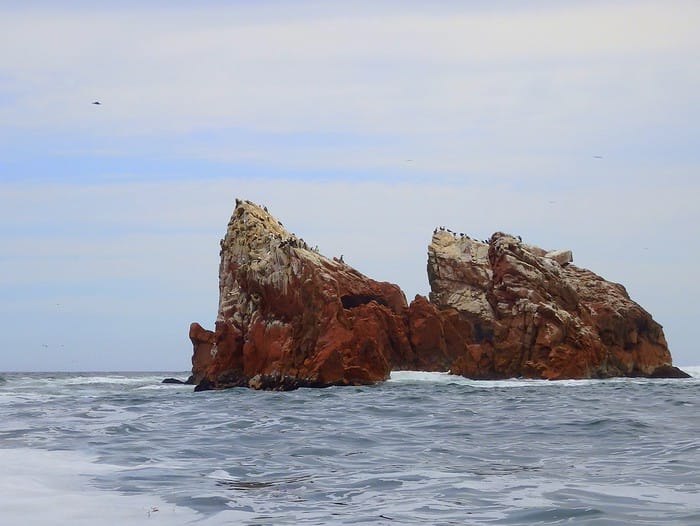
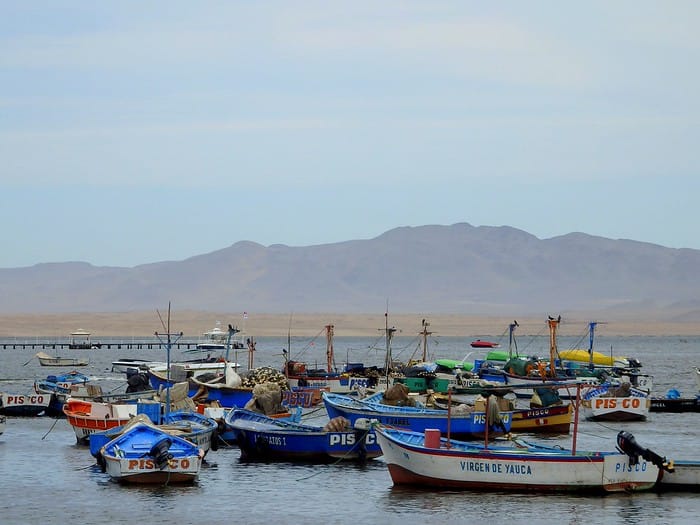

We stopped in Paracas (which is the jump off point for the islands) on our way down to Ica for the weekend. I was a bit worried about showing up without a reservation, but as it turns out, tours for the Ballestas Islands leave quite frequently especially on the weekends when both Limeños and international tourists choose to make the trip to the famed islands.
The main street in Paracas was lined with tour operators offering their services, but we ultimately walked into the boat terminal and booked everything there.
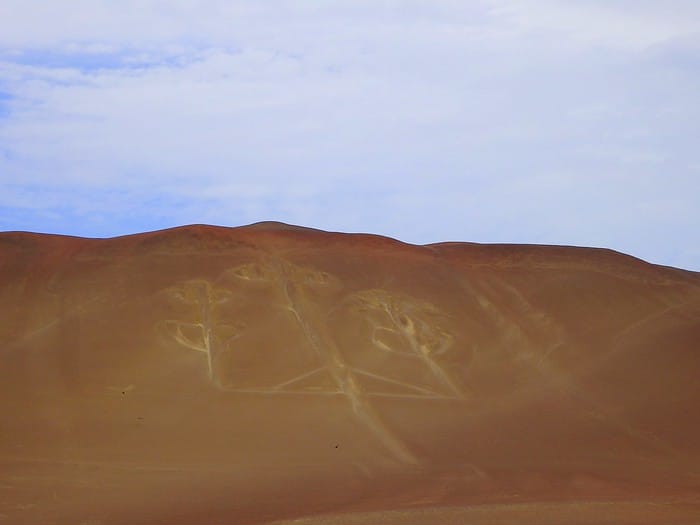
The Paracas Candelabra is 180 meters tall and it can be seen from a distance of up to 12 miles out at sea. The design is carved 2 feet into the ground, and it has been around for over 2000 years. Our guide explained that because of where the candelabra is positioned – on the north shore of the peninsula – the mysterious symbol is shielded from most of the wind. This combined with the arid climate and lack of rain means the Candelabra has been able to withstand the test of time.
Like most geoglyphs around the world, no one quite knows what purpose it served. Our guide shared a number of options including: a marker to guide ships towards the harbour, a symbol dedicated to the Argentine liberator José de San Martín, a representation of a hallucinogenic plant called Jimson weed, and of course, there was even mention of extraterrestrials. The truth is no one really knows.
Incredible Wildlife Of The Ballestas in Peru!
But now on to the wildlife!
We got to see a lot of really cool animals on our tour of the Ballestas Islands. I was mistakenly under the impression that we would set foot on the islands, but the tour boats don’t actually disembark there. It makes sense considering the thousands of animals that make this place their home (I’m sure the sea lions wouldn’t appreciate 30 camera-totting tourists trying to snap their picture several times every hour), however, this also means that you have to appreciate them from a distance.
So what did we see?
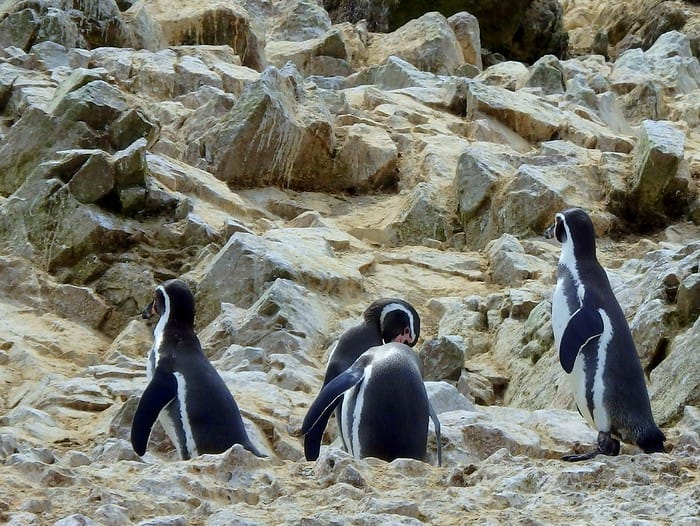
Humboldt penguins looking rather dashing in their suits!
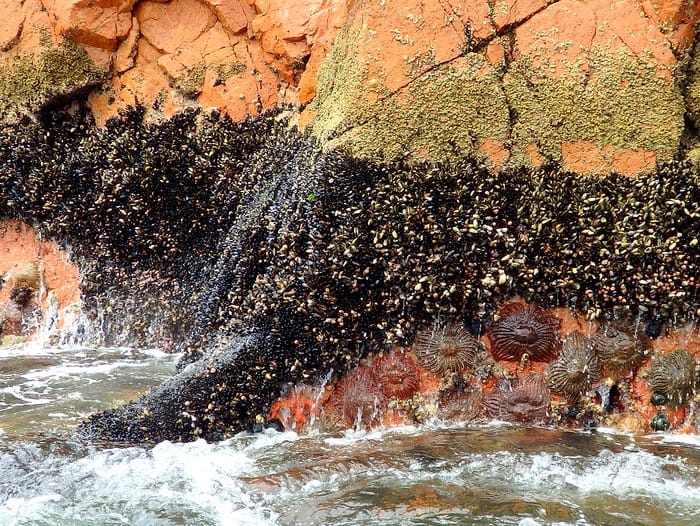
Sunfish, which are similar to starfish except with way more tentacles. I had never heard of these prior to visiting Islas Ballestas.
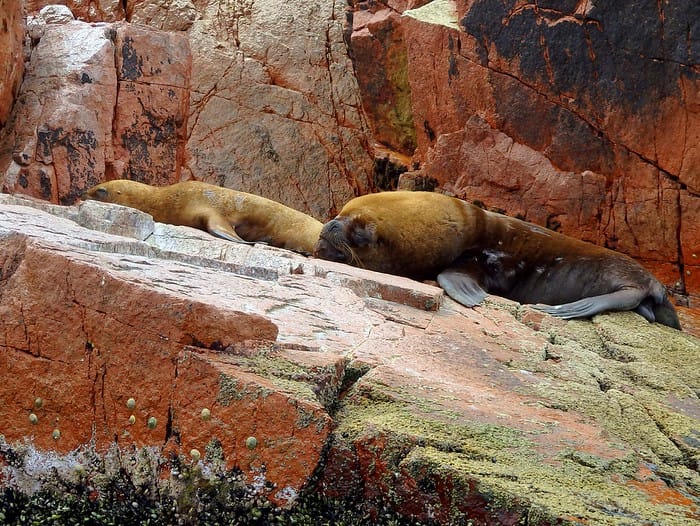
Sea lions lounging in the sun. It’s always nap time when you’re a sea lion.
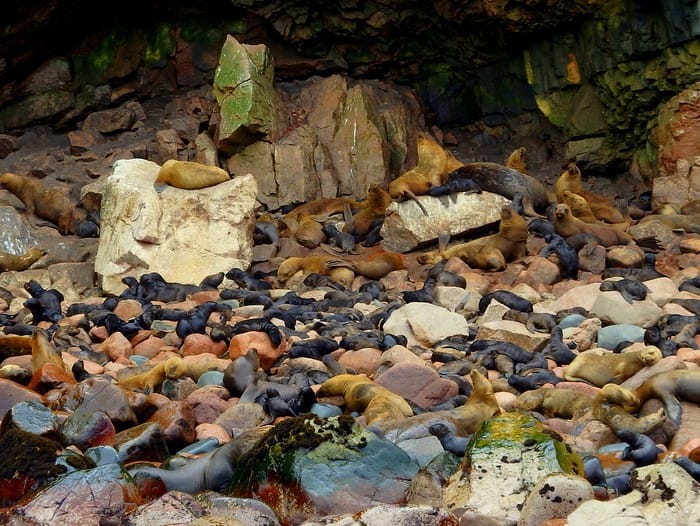
It was birthing season so there were hundreds of sea lion pups. They are the ones that look a bit darker in colour.
There were also pelicans, cormorants, and Inca terns which have red beaks and red feet. I couldn’t get any close up shots of the terns, but you’ll have to trust me when I tell you they are pretty cool looking birds.
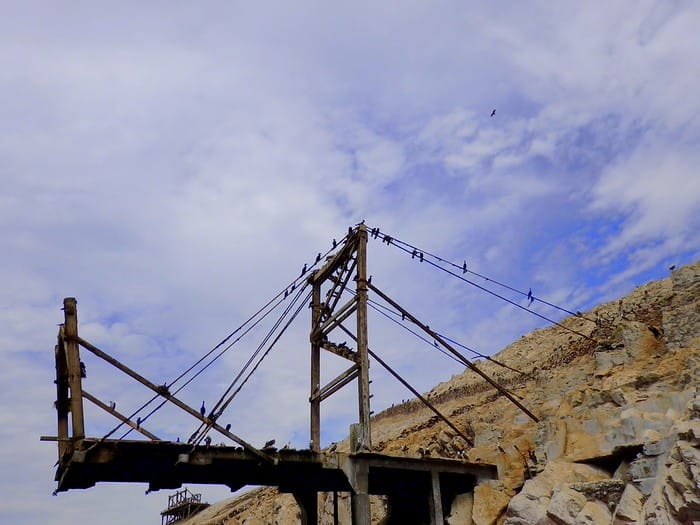
We also learned about the importance of the guano (bird droppings) found on the islands. If this wooden bridge looks a little odd it’s because it’s only intended for use by the guano collectors who scour the islands every 11 years. Due to its richness in minerals like nitrate, phosphorous and carbon, guano makes a great fertilizer and its often used in agriculture. Our guide was explaining that the bird droppings on this islands have actually been used to pay off Peru’s international debt – you’ve got to appreciate the humour in that!

Tips for visiting Islas Ballestas:
- If you get seasick, consider taking some motion sickness pills. Even though the sea wasn’t particularly choppy on the day I visited, the starting-stopping motion made me a little queasy, as did the exhaust fumes coming from the boat every time we started up the engine again.
- Bring a hat and wear sunblock. There won’t be much in terms of shade on the way to the island, or even once you reach the island.
- Choose any seat near the back. Don’t worry about being on the right-hand side or the left-hand side of the boat to get the best shot. Our captain was quite diplomatic and made sure to approach the island from both sides so that everyone could get a good view regardless of where they were seated. There are slightly raised windows to shield you from the wind towards the front of the boat (these don’t necessarily impede your view), but the back is better for photography.
- Bring your telephoto lens! If you want to get some good shots of the animals, it’s worth hauling this lens along. I brought a small point-and-shoot and while I walked away with some cool shots, I couldn’t really capture any of the birds. If you really want to capture the wildlife, you’re going to need something a bit more powerful than what I had.
- Bring a set of binoculars. Lastly, if you’re really into wildlife spotting, it might even be worth brining a set of binoculars to really admire the finer details…otherwise you’ll just be looking at a cliff dotted with hundreds of birds.
Cost
There are 2 different costs associated with visiting Islas Ballestas; the first is the transportation fee and the second is the fee you pay for entering the national conservation area. The 2 hour tour I took cost 40 soles per person ($13 USD) and the national conservation fee was an additional 10 soles ($3 USD). Not a bad deal if you ask me.
Getting there
Islas Ballestas can either be done as a day trip or a weekend trip from Lima. I did the latter and spent the weekend visiting Paracas, Ica and Huacachina. I drove down with my relatives along the South Pan American Highway and it took us about 3 hours to get there. If you’re taking a bus from Lima to Paracas it can take anywhere between 3.5 to 4 hours and buses leave throughout the day.
Paracas: Wildlife-Packed Weekend Around the Ballestas
When to Go & What You’ll See
| Month | Ocean Conditions | Wildlife Highlights | Crowd Level |
|---|---|---|---|
| Dec–Mar (Southern summer) | Glassy mornings, afternoon chop | Sea-lion pups nursing; rare chance to spot green sea turtles | High (Peruvian school holidays) |
| Apr–Jun | Calm, cool °C 17–20 water | Humboldt penguins nest; dolphins often escort boats | Moderate |
| Jul–Sept | Breezy / misty “garúa” fog | Largest guano bird population, dramatic skies | Low-mid (bring a windbreaker) |
| Oct–Nov | Transition—sun by noon | Pelican courtship dances | Rising (pre-Christmas city breaks) |
TL;DR – April and early May win for a sweet spot of wildlife density, calm seas, and lighter queues at the dock.
Choosing the Right Boat Operator
Dock vs. Kiosk Sales
Street sellers quote S/35–S/45 but sometimes overbook and shuffle you to a later boat.
Terminal booth (Muelle Turístico) sets standardized times, caps capacity at 35 seats, includes mandatory life-vests. I paid S/40 and boarded exactly at 08:00.
Spanish vs. Bilingual Guide
Ask explicitly for guía bilingüe. Roughly half the boats broadcast Spanish only, leaving non-Spanish speakers guessing which black blob is a cormorant vs. a booby.Morning (07:45–09:00) or Late-Morning (10:30)
Early boats enjoy calmer swells and better penguin activity (they head to sea by 10).
Later boats can dodge sunrise chill but risk stronger wind chop—bad news if motion sickness stalks you.
Sustainability Check
Look for operators displaying the Reserva Nacional de Paracas “Distintivo Azul” decal; it certifies boat engines meet new low-emission guidelines and captains follow the 30-metre wildlife buffer.
Sample 48-Hour Itinerary
| Time | Day 1 – Desert + Dunes | Day 2 – Ballestas & Beyond |
|---|---|---|
| 07:30 | — | Depart hotel, board 08:00 Ballestas boat |
| 09:30 | Drive into Paracas National Reserve | Return to dock; ceviche brunch at El Che (Malecón) |
| 11:00 | Mirador de La Catedral sea-arch | Taxi to Museo Julio C. Tello (pre-Inca mummies |
| 13:00 | Lunch, Lagunillas fishing cove; order jalea seafood mix | Collect bags, combi to Ica (1 hr) |
| 15:30 | Playa Playa Roja red-sand photos | El Catador winery tour & pisco tasting |
| 17:00 | Return Paracas; sunset paddleboard in bay | Tuk-tuk to Huacachina oasis; dune-buggy sunset ride |
| 19:30 | Seaside dinner at Pisco y Nazca | Overnight in Huacachina or bus back to Lima |
Tight on time? Flip the days and head straight to the 08:00 Ballestas boat on arrival, freeing the afternoon for the reserve.
Where to Sleep
| Budget | Property | Price (dbl) | Perks |
|---|---|---|---|
| $ | Kokopelli Hostel | from US $18 pp (dorm) | Pool, rooftop bar, 2-min walk to dock |
| $$ | Hotel Gran Palma | US $65 | Bay-view terrace breakfast & AC |
| $$$ | Aranwa Paracas Resort & Spa | US $145 | Two infinity pools, private pier—families love it |
| Splurge | Hotel Paracas, a Luxury Collection | US $280 | Yachts, flamingo lagoon, free paddle boards |
Tip: Winds howl at night (Paracas means “rain of sand” in Quechua). Pick a place with interior corridors or double glazing if you’re a light sleeper.
Packing & Photography Cheats
Waterproof dry-bag – salt spray spares no DSLR.
70–200 mm zoom (or 100–400 mm on crop-sensor) – perfect focal length for sea-lion portraits from 20–30 m.
Circular polariser – cuts glare off the guano-whitened cliff faces; boosts penguin contrast.
Quick-dry buff + wide-brim hat – you’ll swing from icy mist to harsh UV within an hour.
Motion-sickness tabs – time them 45 min before boarding; Peruvian brand “Gravol C” costs S/6 at any botica.
Sustainable Wildlife Etiquette
| Do | Don’t |
|---|---|
| Photograph with silent shutter if your camera supports it. | Toss snack scraps—gulls become aggressive beggars. |
| Keep limbs inside boat; startled sea lions can stampede pups. | Fly drones—the reserve banned them after repeated seal disturbances. |
| Support the Red de Tortugas charity stall at the pier (funds marine-debris clean-ups). | Pocket seashells; they’re protected here. |
Pairing with Pisco & Sand Boarding
After the morning swell, most travellers beeline to Ica’s vineyards or Huacachina’s dunes. Getting there is simple:
Colectivo Van Paracas→Ica Plaza de Armas: S/15, 60 min, departs when full (approx. every 30 min).
From Ica, a moto-tuk-tuk to Huacachina Oasis is S/8, 10 min.
Vineyard circuits by taxi (three bodegas + wait time) cost ~S/80 total.
Must-try pisco cocktails? Start with an Ica Sour—pisco infused with sun-dried naranja peels—and finish with a sweet algorrobina shake (pisco, carob syrup, condensed milk).
Cost Breakdown (Per Person, 2 Days)
| Expense | Soles | USD |
|---|---|---|
| 08:00 Ballestas boat | 40 | 13 |
| Reserve entry (Paracas) | 11 | 3 |
| Hostel dorm x1 | 70 | 22 |
| Seafood lunches x2 | 80 | 25 |
| Taxi/van/tuk transports | 60 | 18 |
| Dune-buggy & sandboard | 55 | 17 |
| Pisco tasting flight | 35 | 11 |
| Total | 351 | 109 |
Add S/50 if you can’t resist those aloe-rubbed penguin fridge magnets.
No, the Ballestas aren’t the Galápagos—but that’s precisely their charm. You’ll pay a fraction of the price, spot most headline creatures (minus giant tortoises), and cap the day with ceviche so fresh the plate still smells of surf.

Wow, it looks so different with blue skies and sunshine! I visited Paracas in August 2013, which is of course winter, and it was cold, grey and cloudy the whole time, so it wasn’t really that enjoyable. Looks like it’d be worth another visit in Peruvian summer, for sure.
Blue skies and a little bit of sunshine can make the trip. There have been a few foggy/overcast days here in Lima, but thankfully we’re still enjoying the very tail end of summer.
Good thing you’re not allowed to set foot on there, because if I had gone on that trip, I would have brought a penguin home with me. They’re so cute! 🙂
Haha, yeah they were pretty cute, although they seemed a bit camera shy!
This place looks awesome! never heard of it until now
I hadn’t heard of it during my previous trips to Peru either, so it was nice discovering some new places. 🙂
I think it’s good that they don’t let tourists actually go onto the islands. By the looks of it it seems like it wouldn’t be the best idea for people to interact with the animals. I’ve actually never seen penguins in the wild, so whenever I do finally go to Peru this place is definitely on my list of places to visit. I bet penguins are the best things EVER to observe in the wild. All of those sea lion pups are pretty amazing too 🙂
You’re right. I think it would scare a lot of the wildlife away…I also wouldn’t want to come face to face with a sea lion. Their loud barking was enough for me to keep my distance.
The colors and textures of this location are stunning! It’s so interesting to see penguins in an environment that looks more like a rocky mountain.
It’s a lot rockier than I imagined it would be. There isn’t a lot of vegetation on the islands, so it’s interesting to see animals still making this place their home.
This seems like a really fun trip, it looks like you got really close to the penguins and sea lion pups.
Yes, the boats bring you quite close to the shore – without disturbing the wildlife, of course. 🙂
Hey Audrie, I from Lima and would like to meet you
Have a nice trip
Hi Brad, I’m actually here completing a teaching practicum and visiting family, so I won’t be able to this time around. But thank you for the kind invitation! 🙂
The penguins look so cute and hugable.
It was cool seeing the penguins. I always envisioned them in cooler climates, but they were just enjoying the summer weather and hanging out the island. 🙂
Those sea lions are the cutest!! Audrey you lucky girl!
They were cute – and it was nice seeing the newborn pups too!
Poop paying international debt? Who’d have every guessed that! Great little factoid. And thanks for sharing about the sunfish – I’ve also never heard about it before. In all I’ve heard of Lima I’ve never heard of the Islas Ballestas so thanks for sharing.
I had to laugh out loud when our tour guide told us that! I guess they’ve got to use the resources they have and guano is one of them… 😉
so why are the Islas Ballestas nothing compared to the Galapagos Islands? It seems like there was a pretty diverse amount of wildlife there, except maybe the only bad thing is that you can’t step foot on the island.
Hi Don, the reason they call the Islas Ballestas “the poor man’s Galapagos” is because they are quite small and they are very rocky. There’s hardly any vegetation on them and while you do get to see some wildlife up close, the diversity isn’t what you’d find somewhere like the Galapagos. You won’t spot giant tortoises, blue footed boobies, or albatross in Ballestas. That being said, I got to see some cool species that I had never seen up close before! 🙂
At first I thought that second sea lion photo was just of rocks. Woah, that’s a lot of pups!!
I thought the same thing when we were approaching, Heather! It took my eyes a few seconds to refocus and see that those weren’t rocks!!
Wow, beautiful photos, and it sounds super relaxing! I’ll certainly add it to my list! Platypus at Eungella National Park
What an amazing wildlife experience! I love penguins… but those starfish things were awesome. And what a helpful article too! I hope to make it there someday for sure!
Ashley
Thanks for reminding me of a great trip I had to that region years ago – here what I see to compare how it looked back then : http://travelogue.photography/albums/peru